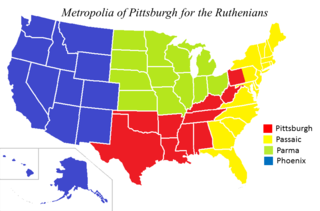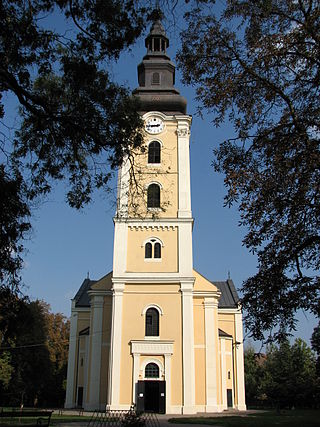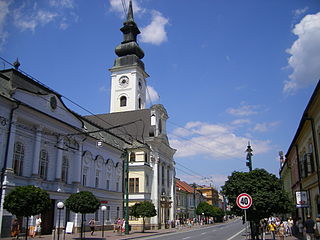
The Eastern Catholic Churches or Oriental Catholic Churches, also called the Eastern-Rite Catholic Churches, Eastern Rite Catholicism, or simply the Eastern Churches, are 23 Eastern Christian autonomous particular churches of the Catholic Church, in full communion with the Pope in Rome. Although they are distinct theologically, liturgically, and historically from the Latin Church, they are all in full communion with it and with each other. Eastern Catholics are a distinct minority within the Catholic Church; of the 1.3 billion Catholics in communion with the Pope, approximately 18 million are members of the eastern churches.

An exarch was the holder of any of various historical offices, some of them being political or military and others being ecclesiastical.
An exarchate is any territorial jurisdiction, either secular or ecclesiastical, whose ruler is called an exarch. Byzantine Emperor Justinian I created the first exarchates during his invasion of the former Western Roman Empire, and the term is still used for naming some of the smaller communities of Eastern Rite Catholics as well as Eastern Orthodox Christians.

The Metropolis of Pittsburgh is a sui juris metropolitan see of the Ruthenian Greek Catholic Church that is located in the United States of America and Canada. The Ruthenian Greek Catholic Church is one of 23 sui juris Eastern Catholic particular churches in the Catholic Church that is in full communion with the Holy See. The metropolis uses the Byzantine Rite in its liturgies. It was erected as a metropolis (archdiocese) by Pope Paul VI in 1969. The metropolis has jurisdiction over those communities that originated from the regions of Carpathian Ruthenia, Slovakia, Hungary and the former Yugoslavia. Worshipers come from several Byzantine Catholic groups: Rusyn Americans, Slovak Americans, Hungarian Americans, and Croatian Americans. In 2022, governance of the Exarchate of Saints Cyril and Methodius of Toronto in Canada passed to the metropolis of Pittsburgh from the Slovak Greek Catholic Church.

The Greek Catholic Church of Croatia and Serbia or Byzantine Catholic Church of Croatia and Serbia, is a particular Eastern Catholic church in full communion with the Catholic Church. It consists of the Greek Catholic Eparchy of Križevci, covering Croatia, Slovenia, Bosnia and Herzegovina, and the Greek Catholic Eparchy of Ruski Krstur, covering Serbia. The Eparchy of Križevci was headed by Bishop Nikola Kekić until his retirement in March 2019, and since then the eparchy is governed by apostolic administrator Milan Stipić. The Eparchy of Ruski Krstur is headed by Bishop Đura Džudžar since his appointment in 2003.

The Catholic Church in Serbia is part of the worldwide Catholic Church in Serbia, under the spiritual leadership of the Pope in Rome. There are 356,957 Catholics in Serbia according to the 2011 census, which is roughly 5% of the population. Catholics are mostly concentrated in several municipalities in northern Vojvodina, and are mostly members of ethnic minorities, such as Hungarians and Croats.

The Hungarian Greek Catholic Church or the Byzantine Catholic Church in Hungary is a sui iuris (autonomous) Eastern Catholic church based in Hungary. As a particular church of the Catholic Church, it is in full communion with the Holy See. Its liturgical usage is that of the Byzantine Rite in the Hungarian language.

The Macedonian Greek Catholic Church or Macedonian Byzantine Catholic Church is a sui juris Eastern Catholic church in full union with the Catholic Church which uses the Macedonian language in the liturgy. The Macedonian Greek Catholic Church comprises a single eparchy, the Macedonian Catholic Eparchy of the Assumption of the Blessed Virgin Mary in Strumica-Skopje.

The Slovak Greek Catholic Church or Byzantine Catholic Church in Slovakia, is a sui iuris (autonomous) Eastern Catholic church based in Slovakia. As a particular church of the Catholic Church, it is in full communion with the Holy See. The church is organised as a single ecclesiastical province with one metropolitan see. Its liturgical rite is the Byzantine Rite. In 2008 in Slovakia alone, the Greek Catholic Church in Slovakia had some 350,000 faithful, 374 priests and 254 parishes. In 2017, the Catholic Church counted 207,320 Greek Catholics in Slovakia worldwide, representing roughly one percent of all Eastern Catholics.
The Eparchy of San Nicola di Ruski Krstur is a Greek Catholic Church of Croatia and Serbia ecclesiastical territory or eparchy of the Catholic Church in Serbia. It was founded in 2003 as apostolic exarchate with territory in Serbia and Montenegro, and was reduced to the territory of Serbia in 2013. In 2018, it was elevated to an eparchy by Pope Francis. Since 2003, it is headed by bishop Đura Džudžar.

The Eparchy of Križevci is a Greek Catholic Church of Croatia and Serbia eparchy of the Catholic Church in Croatia, Slovenia, and Bosnia and Herzegovina. Its current eparch is Milan Stipić. The cathedra is in the Cathedral of the Holy Trinity, in the episcopal see of Križevci, Croatia.
A particular church is an ecclesiastical community of faithful headed by a bishop, as defined by Catholic canon law and ecclesiology. A liturgical rite, a collection of liturgies descending from shared historic or regional context, depends on the particular church the bishop belongs to. Thus "particular church" refers to an institution, and "liturgical rite" to its ritual practices.

Đura Džudžar is a Serbian eparchial bishop of the Greek Catholic Eparchy of Ruski Krstur since 2018. He was previously titular bishop of Acrassus (2001-2018), auxiliary bishop of the Ruthenian Eparchy of Mukachevo (2001-2003), apostolic exarch of Serbia and Montenegro (2003-2013) and Serbia (2013-2018).
The International Bishops' Conference of Saints Cyril and Methodius is the Catholic episcopal conference that includes Serbia, Kosovo, Montenegro and North Macedonia together in a cross-border conference.

The Macedonian Apostolic Vicariate of the Bulgarians, informally Macedonia of the Bulgarians, was one of the missionary, pre-diocesan jurisdiction of the Bulgarian Greek Catholic Church sui iuris.
Acrassus or Akrassos was an ancient Roman and Byzantine-era city in Lydia. in the Roman province of Asia and Lydia. Apparently, it is the same place that Ptolemy calls Nacrasa or Nakrasa, placed on the road from Thyatira to Pergamum.

The St. Nicholas Cathedral also called Ruski Krstur Cathedral is a Catholic cathedral in the town of Ruski Krstur, in the city of Kula, in the European country of Serbia.
The Ruthenian Catholic Apostolic Administration of Bosnia-Hercegovina was a short-lived (1914-1924) pre-diocesan Eastern Catholic jurisdiction, covering Bosnia and Hercegovina.











